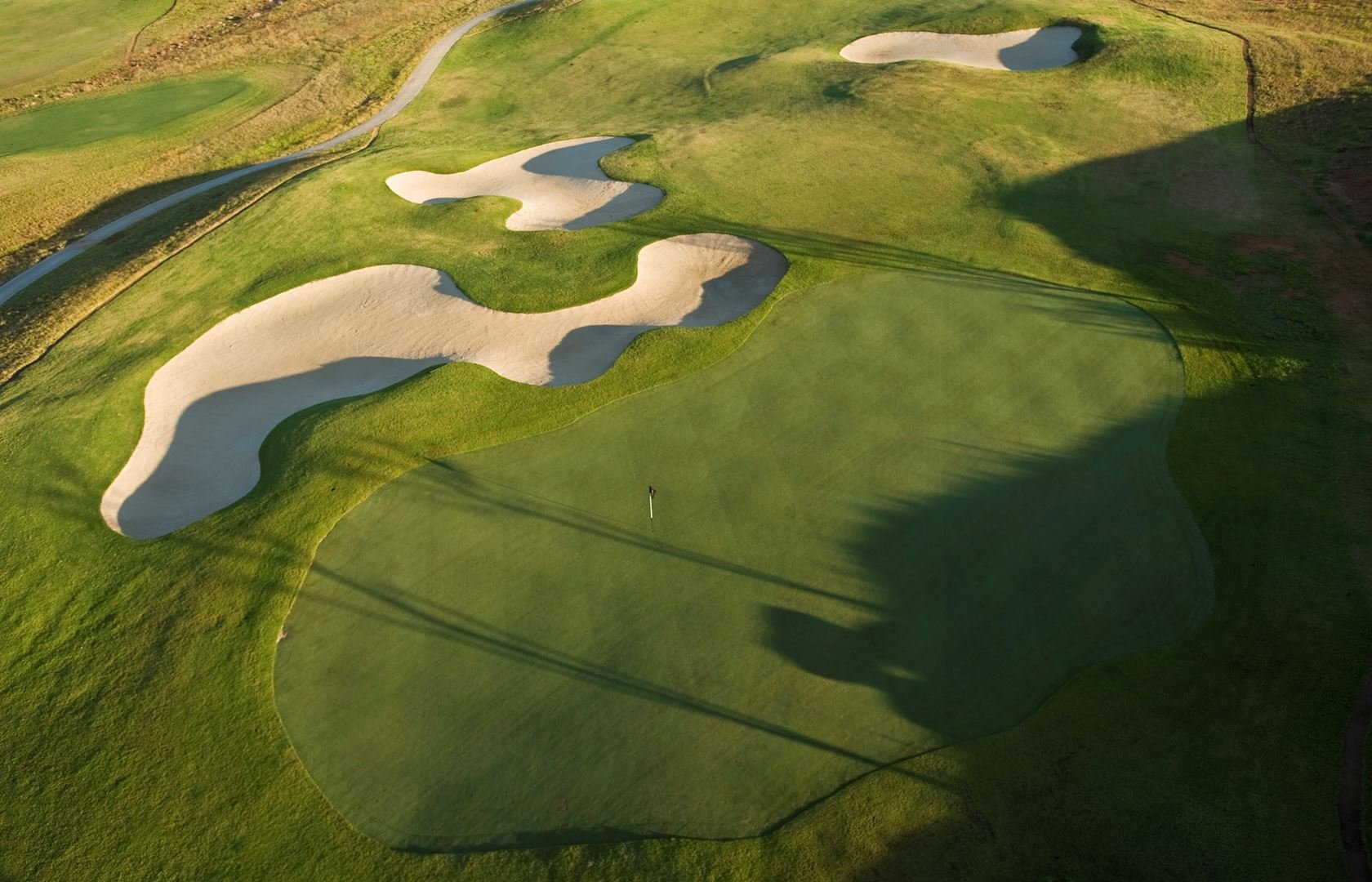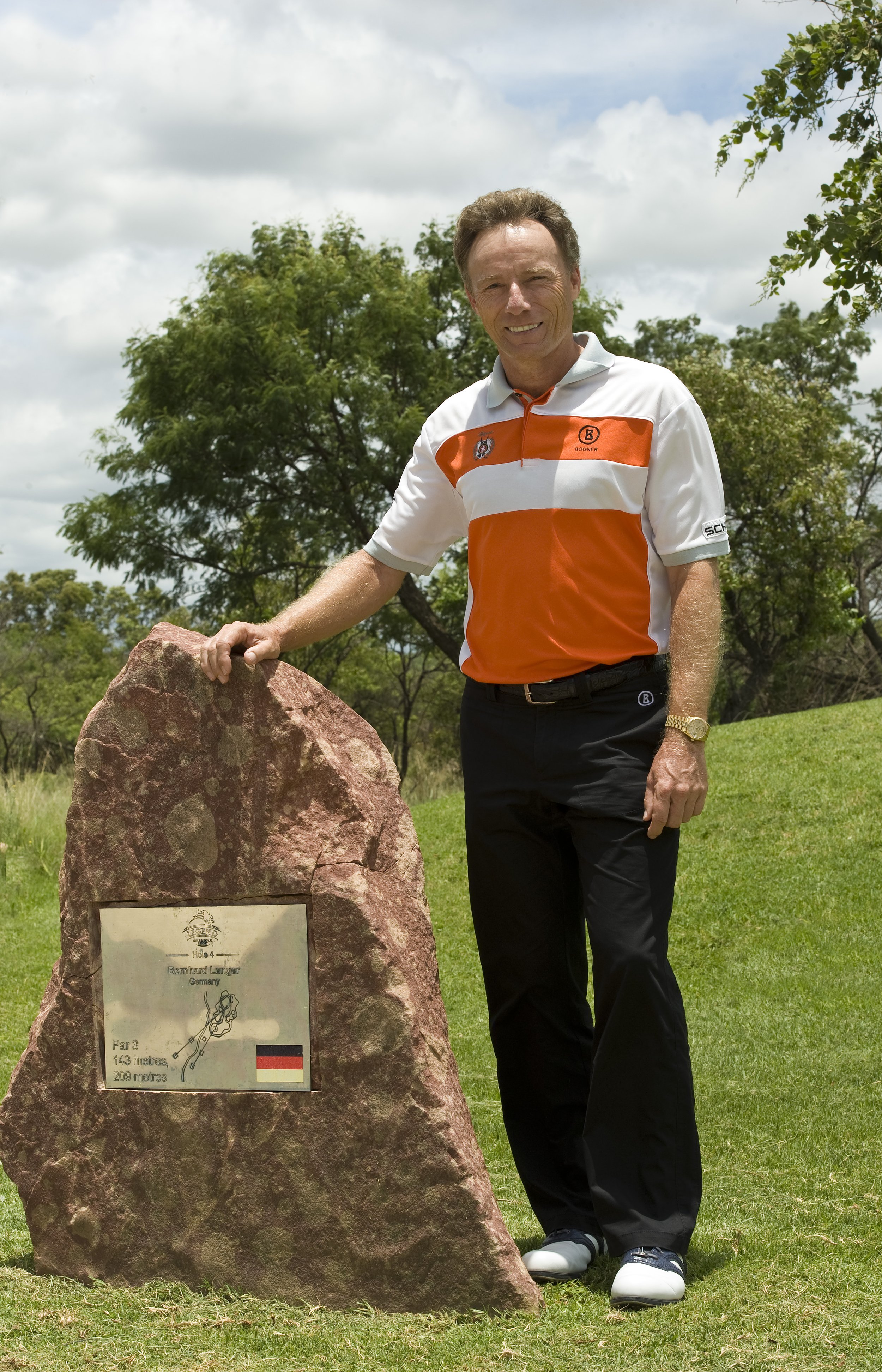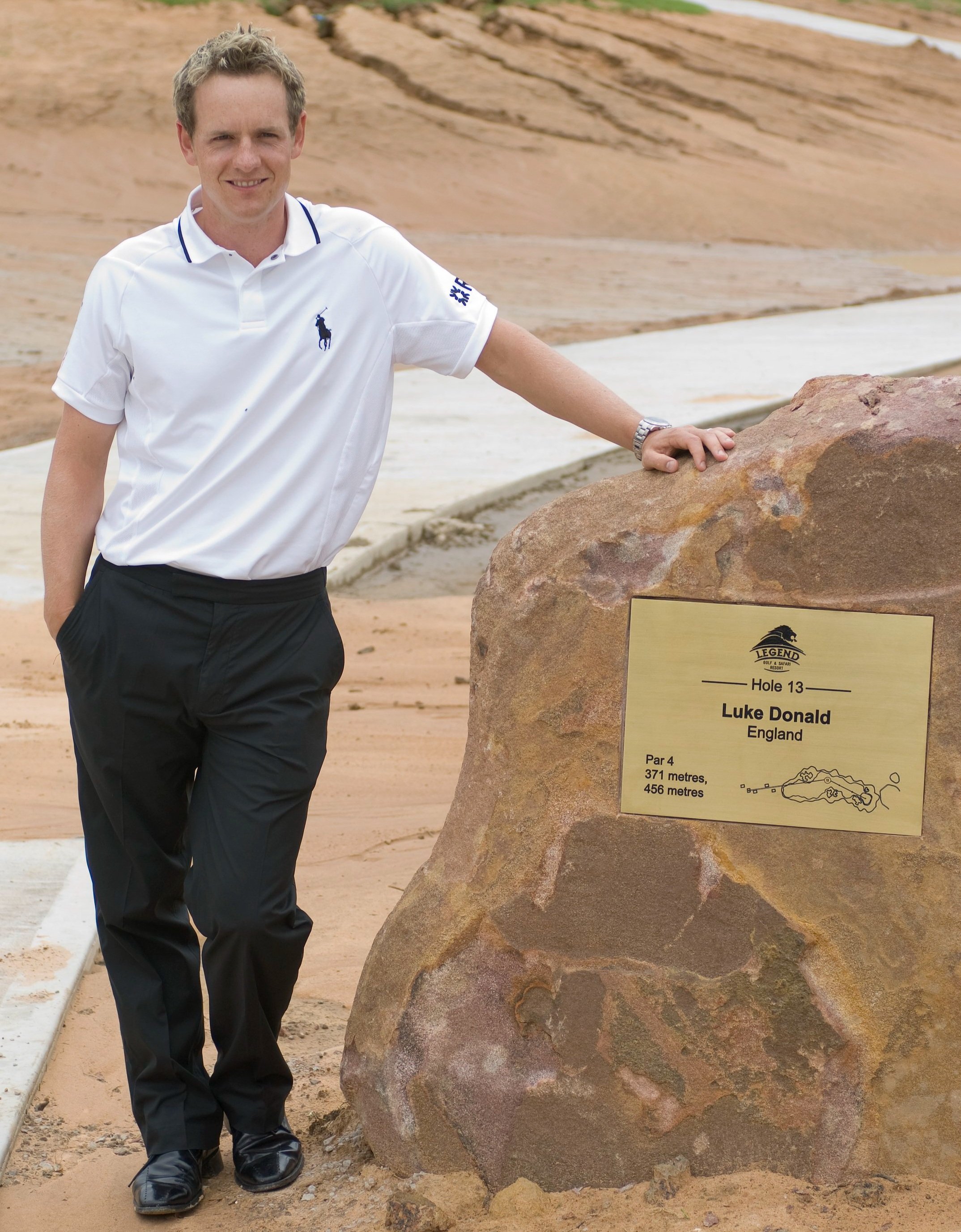THE LEGEND GOLF COURSE.
WHERE LEGENDS PLAY.
The course was awarded South Africa’s top golf course in 2016 and is set in the heart of the 22,000ha Entabeni Big Five Game Safari Conservancy. Here golfers get to play the world’s first 18 Hole Signature Course, all while enjoying the highlights of the African Bush.
The Legend Golf Course offers golfers from around the world a unique once in a lifetime experience.
The Legend Golf Course has been designed as a championship layout with wide fairways and USGA standard greens. It is one of the longest golf courses in the world, playing at 6,534 meters for daily play and having the capability of being extended to a staggering 7,748 meters for tournaments, making this a true African Challenge.
Play golf on a course designed by 18 of the world’s top golfers.
Hit your best drive down the longest golf course in Africa.
Catch a helicopter ride to the highest & most extreme par 3 in the world.
Take a safari drive to see Africa’s Big Five.
THE SIGNATURE GOLF COURSE
The Signature Golf Course is a unique world-in-one course where each hole is designed by one of the world’s top golfers, here professional and amateur golfers can experience the charm of this championship golf course, and tee off at the Par-72, starting off at the hole designed by South Africa’s Trevor Immelman and end off at the Retief Goosen-designed hole.
18 Legendary holes designed by 18 of the world’s Top Golfers.
Hole 1 - Trevor Immelman, South Africa
Par 5, 531 metres, 586 metres.
A wide first fairway greets the golfer. The tees are elevated giving a glorious long view with a magnificent backdrop. The green can be reached with two mighty blows but bunkers await the fade. A St Andrews-like swale left of the green will call for deft approach play. Immelman appreciated the elevated nature of the first tee which makes the starting hole welcoming. Also the generous width of the fairway entices the player to take on the challenge of reaching the green in two, and hopefully resulting in an opening birdie. He wanted the second landing area to be clearly visible for the more conservative lay-up shot. It was suggested that the swale to the left of the green be substantially lower than the green, thus gathering anything but the purest shot and leaving the golfer with the choice between the pitch shot, the bump and run or "Texas wedge".
Hole 2 - Thomas Bjorn, Denmark
Par 4, 418 metres, 485 metres.
The undulating fairway is turned left by directional bunkers down the right side. The exacting second shot is played to a deep and well defended green. Courage is required to find the putting surface which is defended by a lake which wraps almost all around the green, creating an island effect. To be home in two on the second would be an achievement! Bjorn was keen to create an early test in the round. He emphasised that the greenside water hazard be visible so that a successful shot would be a moment to be treasured.
Hole 3 - Jim Furyk, USA
Par 4, 394 metres, 447 metres.
The hole plays slightly uphill and a precise tee shot is called for between bunkers bracketing the fairway. There is a bonus for the bravehearted player who can clear the left bunker. To add piquancy to the shot, a barely visible stream lies in wait! The green calls for precise shot making as it is well guarded by a large bunker and indigenous bushes. Fury believed in tempting the golfer to opt for the aggressive line and offer the reward of an easier and shorter shot to the green. However the penalty for ambition not executed to perfection could well be damaging to the scorecard.
Hole 4 - Bernhard Langer, Germany
Par 3, 143 metres, 209 metres.
The green is set up to receive the incoming ball on the shortest hole on the course. A pin position at the back left will provide a testing target. Two clusters of natural bush frame the putting surface. Langer's input focused on the set-up of the green and emphasised precision, a hallmark of his own game, which should find the reward of a birdie putt. A false front will gather any shot which is less than perfectly judged and leave the player an interesting up and down.
Hole 5 - Michael Campbell, New Zealand
Par 4, 421 metres, 474 metres.
The longest par 4 on the course plays to the furthermost point of the layout before making the turn towards home. The landing area is relatively narrow and the ambitious player should avoid a large bunker to the left. The carry from the championship tee is 310 metres so mere mortals should show prudence! Campbell felt that the hole bearing his name should be a strong one calling for two perfect shots to reach the green. His input was to ensure that only a full-blooded blow would clear the bunker, providing deep pleasure to those happy few who can take on this challenge successfully.
Hole 6 - Colin Montgomerie, Scotland
Par 4, 436 metres, 461 metres.
This downhill hole will play slightly shorter than on the card. Professionals design to suit their own game and here a long fade is the order of the day. The green presents a clearly visible objective for the approach shot which will stop quickly on the receptive putting surface. Montgomerie was looking for clarity of strategy and a hole which rewarded precision of club selection, a feature of his game which has stood him in good stead over the years.
Hole 7 - Mike Weir, Canada
Par 3, 186 metres, 215 metres.
Depending on wind direction and wind strength, a variety of tees offers the player an intriguing challenge. The bunkers fronting the green are clearly visible so that long rather than short play will pay dividends. Weir focused his input on the variety of length and the angle of the tee positions in order to ensure that all levels of golfers would get joy from a well-played hole. Chipping areas left and long add a further dimension to this par 3 and highlight Weir's fondness for interesting short game challenges.
Hole 8 - Camilo Villegas, Colombia
Par 4, 311 metres, 400 metres.
The subtle balance of risk and reward which characterise the entire course is especially apparent in this hole. A wide fairway greets the amateur line. For the brave, their tee shot will need to carry some 260 metres over the target bunker which boasts a punishing face reminiscent of links golf at its most testing. Villegas showed design flair in wanting golfers to make a bold start from the tee. They should decide whether or not to take on the carry bunker and set up an easier approach to the flag. This could hopefully secure the bonus of a birdie. Anything short of pure with the tee shot and a bogey or worse could be the penalty.
Hole 9 - Justin Rose, England
Par 5, 519 metres, 592 metres.
This downhill par 5 will be a handsome conclusion to the opening nine holes. The vista of the valley backdrop will encourage the player to take out the driver, open the shoulders and position the ball on the fairway which is surrounded by water on the right and bunkers on the left. Finding a fairway bunker will force the player to choose the lay-up shot as the lip is daunting. The fairway undulations are deceptive as valleys will shorten the perception of the distance to the green. The penalty for an errant blow could be a watery fate as the green is protected on the right by a lake. Rose wanted to encourage the use of the longest club in the bag and give the player the joy of a downhill drive in one of the most scenic locations in the world of golf. He emphasised that the greenside lake should be clearly visible from a distance as he feels that being able to see the hazards focuses the mind.
Hole 10 - Padraig Harrington, Ireland
Par 4 357 metres, 451 metres.
The start of the back nine plays along a dense cluster of trees to the left of the fairway. The longer the tee shot, the tighter the target, thus calling for accuracy and restraint. The longer and straighter player will gain position by clearing the bunkers and face a testing shot to a green located in an indigenous wetland. Harrington was tempted by "Hogan's Alley" at Carnoustie to set up a shorter pitch to the green for an opening birdie to the back nine. A finger of fairway on the tiger line tricks the brave into playing down "Padraig's Alley"! The more cautious line will leave a longer and more exacting approach with wetlands awaiting the errant play.
Hole 11 - Raphael Jacquelin, France
Par 5 471 metres, 568 metres.
A picturesque hole playing gently uphill with the Hanglip Mountain as a backdrop. Depending on the wind direction, the putting surface could be reached by the longer players in two shots. The tees are located in a natural wetland area. A double dogleg through a cluster of bunkers defines the fairway. Jacquelin wanted this hole to be reachable in two, so the hole was slightly shortened for tournament play. That would encourage the player to seek a birdie with two pure shots. He introduced a turning bunker on the right-hand side to improve the visual orientation of the hole.
Hole 12 - lan Woosnam, Wales
Par 3 210 metres, 250 metres.
The longest par 3 on the course, this hole will test both length and accuracy to the full. The well struck shot ball which lands somewhat short in the apron will still run up to the putting surface. The green is receptive and encourages aggressive play. Bunkers framing the green are quite deep and will call for deft recovery play. Woosnam felt that due to the length of the hole, the entrance to the green should be shaped in such a way that it encouraged the shorter hitter to run the ball through the gap between the cavernous bunkers and so earn the reward of a birdie putt.
Hole 13 - Luke Donald, England
Par 4 371 metres, 456 metres.
An exacting slightly uphill tee shot is required on this hole which plays through the natural vegetation. Due to the prevailing wind which is from left to right on this hole, the green is canted to welcome the shot from the well-defined fairway. Donald is one of the straightest players on the tour. For this strategic hole to which he contributed, it is important to place the tee shot in pole position. He felt that the green's contours should counter the wind direction and permit players to attack the flag with confidence.
Hole 14 - Robert Allenby, Australia
Par 4 415 metres, 480 metres.
The sight of the ball descending through the air towards the vast plain will be memorable. The landing area is clearly defined by large bunkers. Your eyes could fool you in these undulations! The backs of the slopes conceal the yardage from the golfer's perspective and foreshortens the shot. Players should trust the distance indicators more than the eye. Allenby specifically wanted the fairway bunkers to be of the gathering variety: clearly visible and daunting. However he requested that the bunker slopes be firm so that the ball would rarely if ever plug on the face, tending rather to roll back towards the base of the bunker. His golfing experience at Royal Melbourne and Kingston Heath were present in his mind as he planned the bunkering of this hole.
Hole 15 - Vijay Singh, Fiji
Par 4 346 metres, 439 metres.
This hole plays through the dense bush and the change of vegetation and surroundings between the expansive front nine and the back nine is remarkable. The generous fairway has smooth, flowing lines and is reminiscent of links golf at its best. Bunkers run the full length of the hole on the right and prevent the ball running into the bush. Singh's fine driving skills influenced his desire to offer the player a hole which would give free rein from a precise stroke, thus setting up a straightforward approach to the flag. The pot bunker that he added short of the green ensures that the approach carries all the way to the green and rewards distance control.
Hole 16 - Sergio Garcia, Spain
Par 4 363 metres, 463 metres
"Risk and Reward" is the theme of this slightly downhill hole. A well-mounded fairway encourages the safe option but leaves a longer and more testing shot to the green. The taller player will be tempted to take on the carry over the left side bunkers to give a better position from which to attack the narrow green over a prominent tree. A bale-out zone is provided behind the green from whence a par-saving chip could be played. Garcia felt that from the back tees a carry of 265 metres would be just right to test the professionals and give them the satisfaction of an ideal spot for a birdie approach. A swale behind the green would encourage aggressive play so that a ball which had not held the putting surface would not be over-penalised.
Hole 17 - KJ Choi, South Korea
Par 3 158 metres, 195 metres
This hole with its framing bunkers and dramatic backdrop plays directly towards the spectacular Hanglip Mountain some 400 metres above the plain. It is a relatively short hole but you need precision to get to and hold the shallow green. The ball in flight is invariably etched against the ever-changing reddish hue of the mountain. Choi felt that the pleasure of the amateur at this exceptional location would be enhanced if the hole were not overly testing. He offered his ideas for the creation of the green complex as a highlight of the round. A birdie here would be a real bonus!
Hole 18 - Retief Goosen, South Africa
Par 5 484 metres, 577 metres
The course reaches its climax with a downhill drive. Accuracy is demanded from the long hitter as the fairway is defined by bunkers on both sides. Ample space is provided for a strategic lay-up but the target narrows down nearer to the green complex. The green itself nestles behind an expansive lake with an Augusta-like grassy slope leading up to the green. Goosen would have preferred the connection between the green and the lake to be closer in order to hype the drama of the finishing hole. He suggested that the lake be enlarged and integrated closer to the putting surface. Golfers whose shots end up on the sloping bank rather than in the lake can thank Goosen for suggesting that the grass be kept just long enough to prevent a watery end to the round!






































